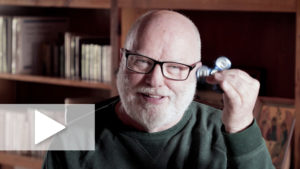
Image and Likeness
God said, “Let us make humans in our image, according to our likeness.” —Genesis 1:26
Over the course of this year’s Daily Meditations, Richard Rohr explores how we can incarnate love in our unique context by unveiling the image and likeness of God in all that we see and do. Each week builds on previous topics, but you can join at any time!
Sign-up now to receive Richard Rohr’s Daily Meditations
Watch a short introduction and continue learning about this year’s theme (or read the unedited transcript):
In his 2018 Daily Meditations, Richard Rohr explores places in which God’s presence has often been ignored or assumed absent. The three monotheistic religions all teach that one Creator formed all things “out of nothing.” There is thus a radical unity at the heart of the universe’s pluriformity, resolving any conflict between diversity and the shared DNA found in all creation. This theo-logic allows us to see “the hidden wholeness” in all things and to confidently assert that “everything belongs,” despite all seeming evidence to the contrary. The distinction between natural and supernatural, sacred and profane, exists only as a mental construct, but never in the mind of the true mystic.
True mystics—those who have learned to see at the deepest, experiential level—know that everything is sacred. As Meister Eckhart said, “This whole world is pregnant with God!” Contemplation helps us see “beyond the shadow and the disguise” of things (Thomas Merton), to perceive reality at its depths. The universal Christ is a helpful name for the inspirited character of all material reality, or as Paul puts it, “He is everything and he is in everything” (Colossians 3:11). To see this is to have “the mind of Christ.”
Centuries of Christian theology confirm that the “image” described in Genesis refers to our eternal essence in God which cannot be increased or decreased. “Likeness” refers to our personal embodiments of that inner divine image. Though we differ in likeness, the imago Dei persists and shines through all created things. There are as many ways to manifest God as there are beings in the universe. Our personal and collective incarnations reveal aspects of the sacred through our personhood, relationships, fields of work and study, culture, economy, and justice.
What some call “sin” proceeds from the illusion of separation and irreconcilable differences—denying the objective divine image in our planet, living things, and any humans who are perceived as “other.” This is the primary source of all suffering and violence. Understanding our shared origin with all of creation gives us a strong foundation for living in loving relationship with all reality. Non-dual consciousness (which Father Richard calls the “contemplative mind”) allows us to be embodied and lovingly present to the sacred in all creatures, not just humans. Such wholeness sees and enjoys wholeness everywhere else—and thus calls it forth.
Richard dives deep into this theme with 1-2 week segments over a full year (see a rough outline below). Every Saturday includes a summary of the previous week’s meditations and an invitation to contemplative practice. “Gateway to Presence” (at the bottom of each meditation) is an invitation to deepen your experience of reading that day’s reflection.
Please join our growing community of people finding support from these meditations in their daily lives. We offer them with our hearts full of hope that they will meet you where you are and provide a contemplative experience. Learn about contemplative prayer and other forms of meditation.
Find previous years’ meditations in the web archive. See 2018 topics linked below.
2018 Outline:
- Introduction: Image and Likeness
- Contemplative Consciousness
- Jesus of Nazareth: Week 1
- Jesus of Nazareth: Week 2
- Sermon on the Mount: Week 1
- Sermon on the Mount: Week 2
- Creation: Week 1
- Creation: Week 2
- Evolution
- The Natural World: Week 1
- The Natural World: Week 2
- Thisness
- Growing in Love’s Likeness
- Human Bodies: Week 1
- Human Bodies: Week 2
- Gender and Sexuality: Week 1
- Gender and Sexuality: Week 2
- Relationships
- Community
- Art: Week 1
- Art: Week 2
- Vocation
- Creativity
- Justice: Week 1
- Justice: Week 2
- Economy: Week 1
- Economy: Week 2
- Politics: Week 1
- Politics: Week 2
- Eucharist
- Perennial Tradition
- Primal and Indigenous Spirituality
- Hinduism
- Taoism and Buddhism
- Judaism
- Early Christianity
- Eastern Christianity
- Western Christianity
- Islam
- Unknowing: Week 1
- Unknowing: Week 2
- Suffering: Week 1
- Suffering: Week 2
- Love: Week 1
- Love: Week 2
- Death and Resurrection: Week 1
- Death and Resurrection: Week 2
- Joy and Hope
- The Universal Christ
- Contemplation: Week 1
- Contemplation: Week 2
- Image and Likeness: Summary
